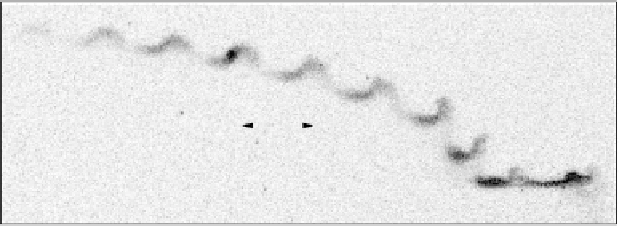Geoscience Reference
In-Depth Information
gradient drift instability in Fig. 6.37b for the topside of a plasma layer similar
to that shown in Fig. 6.37a. The perturbation charges and electric fields that
characterize the electrostatic wave are also shown. The electric field-driven case
is shown in (a) and the neutral wind-driven case in (b).
In summary, the simple extension of equatorial instability theory to mid-
latitude is not very satisfying. Applying global scale electric fields and horizontal
winds to horizontally stratified layers cannot produce plasma structures with
scale sizes larger than a few tens of meters (see Section 6.7.7) due to the mapping
of the large scale wave electric fields along
B
to a stable region.
6.7.4 The Effect of a Wind Shear: The Kelvin-Helmholtz Instability
as a Source of Q-P Echoes
The wind shears discussed in Section 5.3.2 are often high enough to create a
neutral atmospheric Kelvin-Helmholtz instability (KHI). This would result in
periodic uplifts of the neutrals such as seen in Fig. 6.35a and in the plasma
as well, since the ions are tightly controlled by the neutral gas (Larsen, 2000).
One explanation for Q-P echoes involves just such a KHI process. The two
rocket campaigns carried out in Japan to study these instabilities included TMA
releases. Large shears were indeed seen during the events (Larsen et al., 1998,
2005). Bernhardt (2002) has simulated the KHI in the lower thermosphere and
its effects on the plasma layers. Figure 6.38 shows KHI billows made visible
by a TMA trail during the SEEK-2 project. When present the KHI must affect
the plasma but it is not yet clear if they are the primary cause of the Q-P
echoes.
Figures 6.35a-c are a graphic example of the coupling of neutral and plasma
fluids. The sodium atom tracers of the neutral gas shown in Fig. 6.35a reveal
multiple billowing structures typical of Kelvin-Helmholtz shear-driven instability
Uchinoura, Japan — SEEK 2 (S310-32)
3 August 2002 — 23:39 L.T.
5 km
Up
East
North observing site (Kochi) looking south
Figure 6.38
A photographic negative of the TMA chemical release for the Kochi observ-
ing site showing the billowing structure in the neutral wind. [After Pfaff et al. (2005).
Reproduced with permission of the European Geosciences Union.]









Search WWH ::

Custom Search